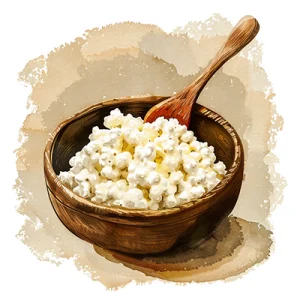WHAT TO DO ONCE YOUR WATER KEFIR GRAINS ARRIVE:
Once you receive your water kefir grains from us, it’s important to get them fermenting as soon as possible. If you’re unable to do that right away ensure you activate them before the use by date stated on the packaging and store them in the fridge until you are ready to start using them.
WATER KEFIR AND METAL:
You will often hear that you should not use metal utensils while making water kefir. Although this holds some truth, it has been greatly exaggerated! Water kefir gets very acidic, if left in contact with metals for long periods of time, in theory it could degrade and rust the metal. That metal would then end up in the water kefir and eventually in you. However, using a stainless steel strainer/sieve or spoon while making water kefir will not cause any problems. The contact time between the metal utensils and water kefir will always be very short. Never leave anything metal in contact with water kefir for long periods of time.
BREWING JAR:
You need something to brew your water kefir in. We recommend using something glass. Glass is much easier to clean and keep sterile. Plastic tends to degrade over time and is prone to scratches which can harbour unwanted bacteria. Plastic also carries a risk of chemical contamination from the materials contained inside of it such as BPA. A glass Kilner style jar is perfect to use.
STRAINER/SIEVE:
You also need a strainer/sieve.
WATER FILTER:
We also recommend you buy a water filter to remove the chlorine from your tap water. You can use bottled water, but this tends to get expensive. You can also use coconut water in place of standard water.
JAR COVER:
You also need something to cover your jar with. We recommend paper kitchen towels as they are easy to discard and replace. You can also use a muslin cloth or similar if you wish. Rubber bands also come in handy to secure the cover to the jar. You can also remove the rubber seal from the lid of any swing-top jar (such as the Kilner jars supplied in our kits). With the seal removed you can close the lid while still allowing airflow during fermentation.
GLASS BOTTLES:
You also need some bottles to store your water kefir in. Again we recommend using glass bottles. We find screw lid style bottles suitable for fermentation work best with water kefir. If you are worried about explosions and glass, you can use plastic bottles. Plastic tends to degrade quickly. It also carries a risk breaking down into the mixture due to the acidness of water kefir. Make sure you use BPA free plastic.
It is important when using glass bottles to check and burp (release some of the gas build-up) on a regular basis to minimise the risk of explosions.
FUNNEL:
It is useful to get a funnel to help pour the liquid into the bottles.
GLASS/PLASTIC MEASURING JUG:
It is also useful to have something to decant your strained mixture into. Glass or plastic measuring jugs are perfect.
WHAT INGREDIENTS DO I NEED?
You only need 2 ingredients to make water kefir, water / coconut water and sugar. However, to improve the drink further, you may also want to experiment with flavouring your water kefir after the initial fermentation. If you use coconut water to make water kefir, it comes with its own flavours and sweetness already and usually does not require any additional fermentation with fruit.
When using water, it must not be chlorinated. This is very important as chlorine will damage and possibly kill your water kefir culture overtime. We recommend using filtered water, which can easily be obtained by using a charcoal-based filter jug. Alternatively, you can use bottled mineral water.
It is best to use cane sugar. Cane sugar is easily broken down by the culture. We only use organic golden granulated cane sugar with our water kefir. However, you do not have to use organic sugar if you do not want too, as refined white sugar also works well. You can also use beet sugar.
Unrefined brown sugar can over mineralise your grains over time. When this happens, grains will start to swell and then break apart forming a mush like layer. This is unhealthy for your grains. We recommend not feeding water kefir grains on dark refined sugars.
As water kefir is a living product, no one can predict how your grains will behave. In time you will learn what works best for your culture.
IMPORTANT: Even though coconut water contains naturally occurring sugars, you will still need to add additional sugar when making coconut water kefir. Coconut water alone does not contain enough sugar for water kefir to successfully ferment. Please add the same amounts of sugar as instructed below.
ACTIVATION:
You need to activate your water kefir grains; this is to revive them from the shipping process. Add 250ml of non-chlorinated water to your jar per 20g of water kefir grains. Add one tablespoon of sugar (15g) per 20g of water kefir grains and stir, so the sugar begins to dissolve. Place your grains in a jar with and cover it. Leave them for 48 hours at room temperature (ideally around 20c). Strain out the water kefir grains and discard the sugar water. It is likely little fermentation has taken place during this stage. So although it might seem wasteful to discard it, you would most likely just be drinking some very sweet sugar water. Your grains are now activated and ready to brew your first batch of water kefir.
THE FIRST FERMENTATION:
Pour 500ml of non-chlorinated water/coconut water per 20g of water kefir grains into your jar. Add one tablespoon of sugar (15g) per 20g of water kefir grains and stir, so the sugar begins to dissolve. You can use warm water/coconut water if you wish, however, we have never found any real need for this. Never use boiling/hot water. This will harm the water kefir grains. Always allow any water to cool back down to room temperature (20c) if needed before continuing.
Never leave any fermenting product in direct sunlight. This can lead to unwanted bacteria and pathogens forming.
Add your water kefir grains to the mixture. Cover the jar and leave it at room temperature (20c) out of direct sunlight for 48 hours. During colder times when the optimum temperature is not being met, you may need to leave the grains longer (72-96 hours) to ferment. We always recommended leaving the grains in the warmest possible location. If this is not possible, it may be worth considering investing in a heat mat or similar device.
At this stage, the water kefir should still taste sweet. This is normal. The sugar left is required to carry out good carbonation (see the second fermentation below).
Strain the water kefir grains out of the mixture using your plastic strainer, decanting the liquid into your measuring jug. This strained liquid is your drinkable water kefir. You can drink this right away if you wish. However, we would advise that you carry out the second fermentation stage on this liquid. Not only will it allow for carbonation (which makes it taste great), it will also increase the bacteria count and reduce the sugar levels further.
If you do not wish to carbonate your water kefir or carry out a second fermentation. We would recommend leaving the strained liquid unsealed at room temperature for a further 3-5 days to increase the bacteria count and reduce sugar levels further.
WHAT TO DO WITH THE GRAINS NOW:
Place the water kefir grains back into your fermentation jar and repeat the process to make a fresh batch of water kefir. Usually, you would do this right away, while you are waiting for the second fermentation process on the batch made previously to finish. This is a continuous brewing cycle.
If you wish to take a break from this cycle, place the grains into the fresh sugar water and place them in the fridge. They can rest in the fridge for up to 3 weeks. Please be aware that an activation process is usually required to revive the somewhat dormant grains from the fridge.
Your grains will grow quite quickly. During the warm summer months, you may find they double in weight every 3-5 days. During the winter, they will usually double in size every 2 weeks.
When brewing water kefir, a good rule of thumb is to use 1 tablespoon of sugar per 20g of water kefir. With a maximum of 40g of water kefir per litre. Too much sugar or too many water kefir grains can lead to over fermentation and more alcohol content. Please be aware that if you are using coconut water, this will contain its natural sugars. This means coconut water kefir will always be sweeter than standard water kefir.
This ratio is a guideline, not an exact science. Trial and error can be a big part of the fermentation process.
THE SECOND FERMENTATION:
It is now time to flavour your strained water kefir. At this point, your water kefir should still taste sweet. This is expected and does not mean your fermentation has failed. It is important for some sugar to remain for the carbonation process to work.
You can use many different things to flavour water kefir. Chopped fruit (cut small so it can be added to the bottles), fruit juice and herbal tea are some of the most common.
THE CARBONATION PROCESS:
Using your plastic funnel, pour the flavoured liquid into your glass bottles and then seal them by closing the lids The bottles need to be 100% airtight. In the summer leave the bottles for 3-5 days until carbonated. During the winter it can take up to 10 days. Check the bottles every 3 days for signs of carbonation by gently opening the lids to listen for gas. Water kefir can get very fizzy in the summer. Always ensure you use bottles designed to hold carbonated drinks to avoid the risk of explosions.
For fizzy water kefir, it is important to use something fully airtight in the second fermentation process. If you are not getting much fizz, this usually means air is escaping from your container. It could also mean that the bacteria have already used all the sugar in your mixture. A small amount of sugar needs to be present to allow gases to be produced by the fermentation process. Usually, if you’re adding fruit, this will contain the additional sugar required anyway.
The water kefir is now ready to drink. Place your bottles in the fridge to cool. Be very careful when opening the bottles as water kefir produces a very fizzy beverage.
Water kefir will keep in the fridge for around 30 days unopened. Once opened, it is best consumed within 3 days.
PLEASE NOTE:
If you have more than one fermenting food culture at home, we recommend that you keep them at least 1 metre apart from each other at all times. This is to stop cross contamination of the different cultures. If you are working with dairy in particular, this is very important. Please contact us is you require further assistance with fermenting more than one culture.





